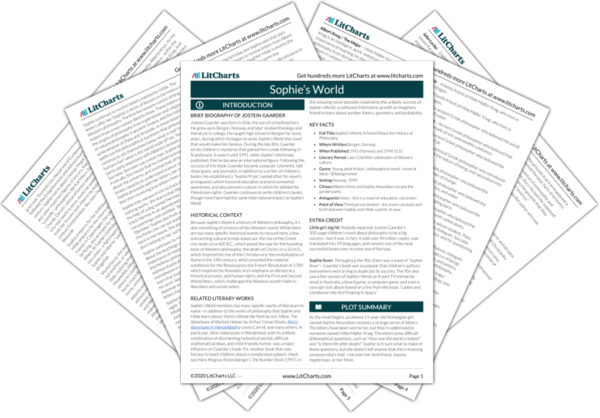Philosophy, Wisdom, and Wonder
The defining theme of Sophie’s World is, pretty clearly, philosophy. As the book moves along, Sophie Amundsen, a teenaged girl, learns important lessons in the history of Western philosophy from her teacher, Alberto Knox. Alberto, an intelligent man, guides Sophie through the ancient Greeks, the medieval thinkers, and Enlightenment and Romantic idealists. All this should make us wonder which philosophical ideas Alberto and Sophie believe to be true. More broadly, we might want…
read analysis of Philosophy, Wisdom, and WonderThe Nature of Reality
Sophie’s World may be a book about Western philosophy, but it’s (inevitably) too short to encompass all of Western philosophy—it has to pick and choose which aspects of this subject to focus on. It’s important to note that while the book outlines many of the major questions of philosophy, it’s a little more interested in answering some of these questions than others. When Alberto Knox reviews Spinoza, Locke, Kant, Plato, etc…
read analysis of The Nature of RealityEducation, Mentorship, and Coming of Age
Sophie’s World isn’t just a history of philosophy. It’s also the story of how two people, a young woman named Sophie Amundsen and another young woman named Hilde Møller Knag, come to apply philosophy to their own lives. In this sense, the novel is a coming-of-age story: a dramatization of how Sophie and Hilde use their educations to gain a new sense of maturity and self-control.
As in any good coming-of-age story, Sophie and…
read analysis of Education, Mentorship, and Coming of Age
Free Will
It’s probably fair to say that the most important and relevant philosophical question in Sophie’s World is “what is real?” but the question “what is freedom?” is nearly as important. As Sophie Amundsen becomes aware that her “world” is a literary creation in the mind of Albert Knag, she begins to wonder if she has any real freedom—any control over her own actions. And this question is by no means limited to Sophie and…
read analysis of Free WillWomen and Sexism
It’s important to keep in mind that Sophie Amundsen isn’t just a young philosophy student—she’s also a young woman. Because of her gender, Sophie has to contend with various expectations about how she should behave—for example, that she should have a boyfriend, should enjoy hosting parties, etc. Because Sophie faces sexism so often in the novel, it’s strongly implied from the beginning that philosophy might be a way for her to escape this sexism, or…
read analysis of Women and Sexism











